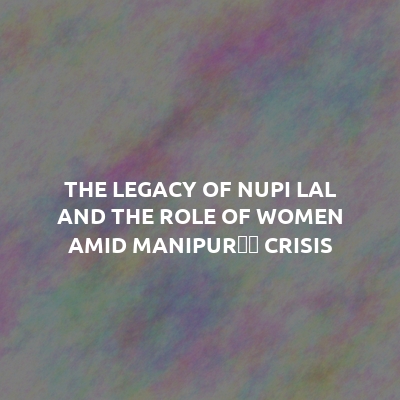As Manipur marks the 85th anniversary of the Nupi Lal (Women’s War), the significance of this historic movement resonates deeply in the context of the state’s ongoing turmoil. The Nupi Lal movements of 1904 and 1939 were emblematic of unity, resilience, and the determination of Manipuri women to resist exploitation and injustice. Today, as Manipur faces a multifaceted crisis—marked by ethnic conflict, mistrust, and societal fragmentation—the lessons of Nupi Lal are more relevant than ever.
The Nupi Lal movements were a powerful response to colonial oppression and policies that undermined the livelihoods of Manipuri people. In 1904, women rose against forced labor imposed by the British, and in 1939, they united to protest the monopolization of rice, which had led to widespread famine. These events highlighted the extraordinary strength and leadership of women, who, despite being marginalized, became the vanguard of resistance and change.
However, in today’s Manipur, the very unity that defined the Nupi Lal seems to be unraveling. Divisive forces, including political actors and vested interests, have actively stoked tensions among communities, and women have not been spared from this orchestrated fragmentation. The role of women, historically central to upholding peace and justice, is being manipulated to serve divisive agendas. Women, who were once symbols of unity and collective action, now find themselves at odds, divided for mere political gains.
This division is not merely a social consequence but a deliberate strategy to weaken the cohesive strength of the state’s womenfolk. Political opportunism, combined with unchecked violence and institutional failures, has eroded the solidarity that once empowered Manipuri women to lead transformative movements like the Nupi Lal. This fracture undermines the possibility of a unified response to the state’s challenges and perpetuates a cycle of mistrust and conflict.
Despite this, Manipuri women remain at the forefront of the ongoing crisis. They are leading protests, negotiating peace, and providing care to those affected by the violence. Women from all communities are striving to bridge divides and advocate for justice, often at great personal risk. However, their efforts are hampered by the lack of institutional support and the manipulative tactics of forces seeking to deepen the divisions within the state.
The legacy of Nupi Lal reminds us that women are not just victims of conflict; they are agents of change. The women of 1904 and 1939 transcended ethnic and communal boundaries to unite against common adversities. Today, there is a pressing need to rekindle that spirit of unity and collective resistance. Women’s voices must not only be amplified but also freed from the shackles of divisive narratives imposed by external forces.
To honour the legacy of Nupi Lal, Manipur must empower its women to lead the way toward healing and reconciliation. This requires addressing systemic inequalities, dismantling divisive structures, and fostering platforms for women to collaborate for peace. The government, too, must play a constructive role, moving away from policies or actions that exacerbate divisions and instead supporting inclusive initiatives that strengthen social harmony.
As we commemorate Nupi Lal, let it serve as a call to reclaim the unity and resilience of Manipuri women, ensuring that their strength once again becomes a beacon of hope in the state’s darkest hours. The enduring lesson of Nupi Lal is clear: collective strength and solidarity can overcome even the most formidable challenges. It is time to revive that legacy to rebuild a peaceful, inclusive, and just Manipur.
The legacy of Nupi Lal and the role of women amid Manipur’s crisis
682



